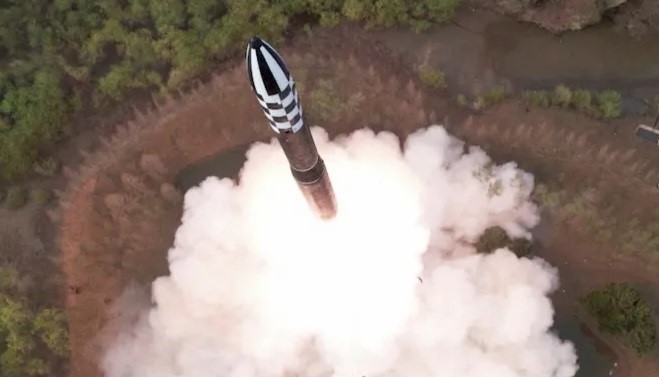

On Wednesday, North Korea launched its Hwasong-18 intercontinental ballistic missile (ICBM) for the second time. The missile uses solid-fuel technology, which allows it to launch with minimal preparation.
Solid propellants consist of a mixture of fuel and oxidiser, with metallic powders like aluminium serving as the fuel and ammonium perchlorate as the most common oxidiser.
{alcircleadd}
The fuel and oxidiser are held together by a hard rubbery material and packed into a metal casing. When the propellant burns, it generates massive amounts of energy and temperatures of over 5,000 degrees Fahrenheit, creating thrust and lifting the missile from the launch pad.
Solid fuel is an old technology that dates back to Chinese firework-making centuries ago. However, it made significant progress in the mid-20th century when the U.S. developed more potent propellants. North Korea uses solid fuel in a range of small, shorter-range ballistic missiles, while China started testing solid-fuel ICBMs in the late 1990s.
France developed its S3, also known as SSBS, a medium-range ballistic missile, and the Soviet Union fielded its first solid-fuel ICBM, the RT-2, in the early 1970s. South Korea claims to have "efficient and advanced" solid-propellant ballistic missile technology, but only for much smaller rockets so far.
Solid fuel is denser and burns more quickly, generating thrust over a short time. It can remain in storage for an extended period without degrading or breaking down, which is a common issue with liquid fuel. Solid-fuel missiles are easier and safer to operate, require less logistical support, and are harder to detect, making them more survivable than liquid-fuel weapons.
North Korea has claimed that the development of its new solid-fuel ICBM, the Hwasong-18, would "radically promote" its nuclear counterattack capability. After the first launch, South Korea's defence ministry downplayed the testing, saying that the North would need "extra time and effort" to master the technology. On Thursday, a ministry spokesperson stated that they were still analysing the latest launch.
A senior-level officer from U.S.-based Carnegie Endowment for International Peace explained why large entities with missile-based nuclear forces would always be eager to procure solid-propellant missiles that do not need fast fuelling before the launch. "These capabilities are much more responsive in a time of crisis," Panda attested.
Responses








